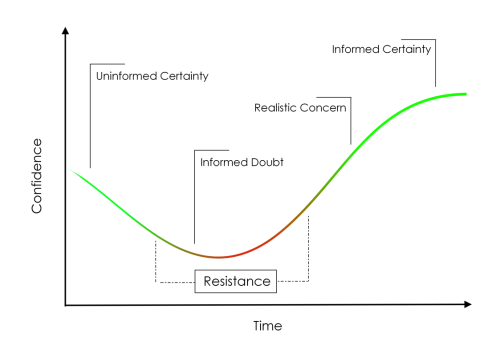By Elisabeth Goodman, 5th September 2019

Illustration from Boyatzis et al, “Coaching for Change – how to help employees reach their potential”, HBR Sept-Oct 2019, pp. 151-155
Why this blog?
The ability to coach is an invaluable, if sometimes daunting, management skill, as well as something that I and my colleagues at RiverRhee offer to support our clients. So I am starting a new series of blogs, under the main heading of “The manager as coach”, the first of which appeared recently as a LinkedIn post …”when a direct report is grieving”.
The article by Richard Boyatzis, Melvin Smith and Ellen Van Oosten in the latest issue of Harvard Business Review (Sept-Oct 2019) caught my eye. This was partly because of the topic, partly because Boyatzis is also a co-author of the Building Blocks of Emotional Intelligence that I so enjoyed reading in 2018-19. (See my blogs on this theme culminating in Inspirational leadership through the lens of emotional intelligence.)
As the authors of this article point out, we often get caught up in the minute details of problems or situations that people are dealing with. It may be however that these issues are symptomatic of some bigger personal change that the individual wants to address.
This article provides guidance on how to spot the opportunity for coaching in this context, and how to go about supporting what Boyatzis defines as “intentional change” (see definition in the notes to this blog).
spot the opportunity
As with all activities involving change, it’s a question of finding the opening for making it happen: when an individual will be at their most receptive and energised for this.
The authors of the HBR article reinforce something that I wrote about in Defining a positive vision for change: people change either because they are moving away from something that is painful or uncomfortable, or because there is something positive, attractive or desirable that they want to move towards.
As the HBR authors say, it’s about spotting when people are ready “to grow” – in terms of what they are saying, or not saying, and their body language when you are observing or interacting with them.
I continue to really like the clean language question: “What would you like to have happen” as a prompt for discovering, and helping the individual to discover, what that opportunity for change might be. It seems to be a great way to provide clarity when people are otherwise getting bogged down and maybe even overwhelmed by the problems they are dealing with.
Help to put the groundwork in place
There are lots of great tips in the HBR article for ways to help an individual articulate what they want to achieve, how the current situation relates to that, and what their next steps might be to bridge the gap. This process is a variation on the GROW model, and on Appreciative Inquiry, that I’ve written about elsewhere.
Boyatzis et al emphasise the importance of creating a positive environment for this discussion: people will be much more open, receptive and ready to reflect and learn in such a situation.
I’ve been experimenting with Barefoot Coaching‘s beautiful picture cards as one way to do this. I’ve found that the colourful nature of the picture cards and the way that they help people to step a little outside the intensity of personal reflection are really conducive to this. Some of the pictures even result in expressions of joy or laughter!
(By the way, a visit to a museum shop is also a great source of colourful and diverse cards for this kind of activity. I have a collection from the Fitzwilliam Museum including drawings by Quentin Blake that people also enjoy.)
The authors also talk about the importance of compassion. It is about communicating your sincere interest in the individual, your empathy for their situation, your desire to help. This involves really good listening skills on the part of the manager or coach: total focus on the individual, and un-biased / non-suggestive open questions. The authors suggest that you let the individual do “at least 805 of the talking”!
Another key component of setting the groundwork is helping the individual create a compelling vision of what they want to achieve: how they see themselves ‘at their best’.
Finally, I like the authors’ point that “the learning agenda is not a performance improvement plan designed to address shortcomings”. It is all about leaving people “energised and empowered to improve”.
provide follow-through support
To close, we know that any form of change requires time, effort and practice – it can be really challenging. So the manager or coach needs to be there, to check-in periodically, to encourage and provide support as needed. What form this will take is something to agree with the individual, and to keep under review as appropriate.
I like the HBR article authors’ idea of the individual creating a peer support network, or “compassionate catalysts”. As one of their case study leaders (Karen Milley – R&D Head at a large consumer goods company) says: “I’m seeing that compassion with each other leads to compassion with customers, constituents, and all others, which creates performance.”
This is something that we try to create through “Action Learning Groups” in RiverRhee’s training for managers – where the delegates form groups to support each others with their learning and forward plans, both during and potential following the course.
The authors’ final point: “If you’re a manager, your most important job is to help those around you reach their greatest potential.” I agree.
Notes
To quote the article, “intentional change involves envisioning ..who you wish to be and what you want to do..; exploring [the current gaps and strengths that might help you to get there]; developing a learning agenda (a road map for turning aspirations into reality); and then experimenting and practicing (with new behaviors and roles).”
Elisabeth Goodman is the Owner and Principal Consultant at RiverRhee Consulting., a consultancy that specialises in “creating exceptional managers and teams”, with a focus on the Life Sciences. (We support our clients through courses, workshops and personal one-to-one coaching.) Elisabeth founded RiverRhee Consulting in 2009, and prior to that had 25+ years’ experience in the Pharmaceutical Industry in line management and internal training and consultancy roles supporting Information Management and other business teams on a global basis. RiverRhee is a member-to-member training provider for One Nucleus.
Elisabeth is accredited in Change Management, in Lean Sigma, in Belbin Team Roles, MBTI (Myers Briggs Type Indicator) and is an NLP (NeuroLinguistic Programming) Practitioner. She is a member of CILIP (Chartered Institute for Library and Information Professionals) and of APM (Association for Project Management) in which she was a founding member of the Enabling Change SIG.
























